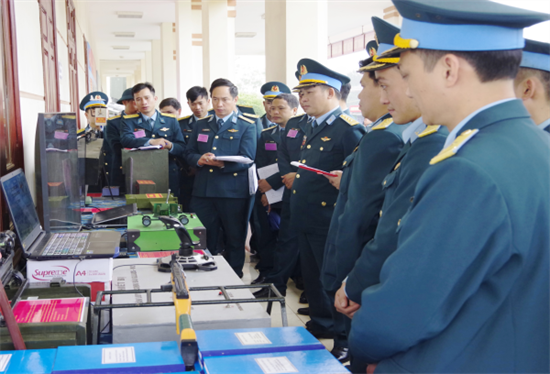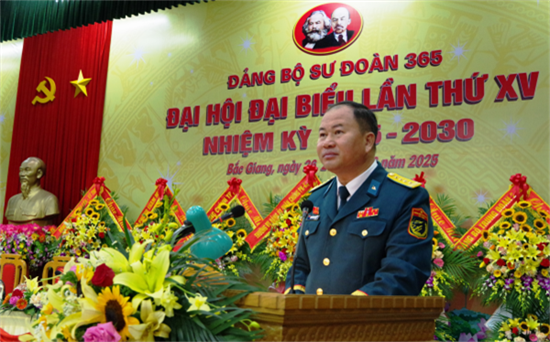Air Defence Division 365 further applies science, technology, innovation, and digital transformation
Amid opportunities and challenges in air combat in the digital era, Air Defence Division 365 has focused its leadership and direction on applying science, technology, innovation, and digital transformation, thereby creating a breakthrough in raising the quality of managing and protecting the Fatherland’s airspace.
 |
| A contest on preparatory work for training held by the Division |
Air Defence Division 365 (Air Defence - Air Force Service) is tasked with managing and defending the Fatherland’s North and Northeast airspace - an area of strategic importance in terms of defence and security. In the process, a part from advantages, the Division is faced with a lot of difficulties caused by the large area of its responsibility, the dispersion of its affiliates, complex terrains, and harsh weather conditions; moreover, its cadres and soldiers are regularly on combat readiness duty. Meanwhile, the robust development of military science and technology has led to the birth of many types of modern weapons and means of air offensive as well as new air combat methods and artifices, thus imposing new task requirements on the Air Defence - Air Force Service in general, the Division in particular. Besides, under the guidelines on building a modern Air Defence - Air Force Service, the Division is provided with new-generation, modern weapons, which necessitates the Division mastering science and technology. Against that backdrop, over the years, the Division’s Party Committee and Command have focused on applying science and technology to raise the Division’s task performance, seeing this as a key to realising the goal of mastering and effectively exploiting modern weaponry. Many scientific and technological initiatives and models in simulation training, command and information automation, and integrated radar and firepower systems have been effectively adopted to contribute to improving the Division’s synergy and combat readiness capacity. In 2024, the Division organised a live-fire exercise with shorter duration for shifting combat readiness states and a breakthrough in detecting and tracking targets.
Right after the issuance of Resolution 57-NQ/TW, dated 22 December 2024, by the Politburo, Resolution 3488-NQ/QUTW, dated 29 January 2025, by the Central Military Commission, and Resolution 1953-NQ/ĐU, dated 28 February 2025, by the Air Defence - Air Force Service Party Committee on breakthroughs in science - technology development, innovation, and digital transformation, the Division’s Party Committee and Command have regarded those documents as a favourable condition for further applying science, technology, and digital transformation in airspace management and protection in the new situation. Thus, the Division has released its own Resolution and Action Plan on science - technology development, innovation, and digital transformation appropriate to the particularities of a specialised combat unit, considering this as a central political mission. In the time to come, the Division will continue taking synchronised measures, with a focus on enhancing leadership and direction, applying modern technologies, consolidating its organisational structure, and raising the quality of its manpower.
First of all, the Division will strengthen all-level party committees and commands’ leadership and direction over science - technology application and development, innovation, and digital transformation. It will direct its units to keep grasping higher echelons’ guidelines, especially its own Resolution and Action Plan, proactively review, adjust, and supplement targets and measures set in these units’ action plans/programs in accordance with each task, each month, and each quarter. At the same time, due attention will be paid to enhancing political and ideological education to make a huge change in awareness and a sense of responsibility towards this important task among all troops, particularly all-level party committees and commands. With the spirit of “only discussing how to do it, not how to back down”, the Division will consolidate the Steering Board for Administrative Reform and Digital Transformation, establish the Board for Science - Technology Development and Innovation, delegate duties to each member of those boards, and issue work regulations for those boards. Besides, it will intensify inspection work, opportunely detect, commend, and multiply effective models and approaches, point out drawbacks, draw lessons, and adjust action plans relevant to realities, with a view to making a fundamental change in troops’ awareness and action and greatly contributing to successfully accomplishing all assigned missions.
 |
| The Division’s 15th Party Congress for 2025 - 2030 tenure |
Additionally, the Division will place emphasis on applying digital technology in training and combat readiness. As a result of the guidelines on building a modern Service, over the years, the Division has been provided with modern equipment, such as VRS - SRS observation posts and VRS - 2DM radar systems, which has allowed the Division to closely manage and firmly protect the Fatherland’s airspace, and avoid falling into passivity in any circumstances. To meet its task requirements in the new conditions, the Division will further apply simulation, virtual reality (VR), and augmented reality (AR) technologies in technical and tactical training, particularly for combat crews, technical and reconnaissance troops, and radar stations. It will bring into play the effectiveness of “digitalised” training models integrated with air defence operations, such as reconnaissance, target detection, firepower control, and handling of situations on digital maps. To effectively deal with low-flying targets and unmanned aerial vehicles (UAV), the Division will direct its affiliates to enhance data connection and sharing between military radar, civil aviation radar, and eye observation stations in order to opportunely give information to all-level headquarters. At the same time, the Division will maximise the capabilities of new military hardware, jamming-resistant systems, and electro-optical systems, conduct researches and evaluations, propose plans for the “dense deployment” of radar systems, and establish a “multi-layered” firepower posture to ensure early detection, rapid warnings, and accurate strikes. The Division will strictly maintain duty regulations for commands and combat teams and practise combat readiness plans including new technologies for dealing with air defence combat scenarios.
Fully understanding that manpower plays a deciding role in digital transformation and innovation, the Division will place special emphasis on training, fostering, and development of digital human resources. Based on higher echelons’ direction and its practical conditions, the Division will select and deploy its cadres and technical employees to join specialised training courses on science, technology, and digital transformation held by training centres both inside and outside the Military, while organising refresher courses on information technology, automation, cyber warfare, information security, and digital transformation for its staff members and developing models, such as “Digital Units” and “Digital Soldiers”. Those refresher courses will be centred on skills to use simulation software, digital data management, and integrated combat system operation. Those courses will help develop its troops’ technological thinking and new approaches relevant to the requirements of modern air defence amid the increasing prevalence of asymmetric and non-traditional warfare. Grasping the instructions on “lifelong learning” given by General Secretary To Lam, the Division’s Party Committee and Command will firmly require cadres, employees, and soldiers in each office and unit to actively take part in “Digital Literacy” platforms. At the same time, the Division will encourage its cadres and soldiers to be active in self-study and update themselves on new technologies relevant to training, combat readiness, and airspace management, such as artificial intelligence (AI), control automation, big data, information security, and digital signal analysis.
 |
| A training session for troops of Regiment 284, Division 365 |
To lay a solid foundation for digital transformation, the Division will continue to give advice on upgrading its information technology equipment, digital infrastructures, military data transmission networks with high bandwidth, reliability, and security to meet the requirements of real-time command and air defence combat. It will adopt modern cyber security solutions, such as encrypted transmission lines and new-generation firewalls. It will organise cyber defence exercises to protect headquarters and weapon systems from electronic warfare and cyber attacks. Besides, the Division will enhance the application of science, technology, and innovation in management, operations, and logistics and technical support work. In order to realise the goal of managing all directing and operating documents in digital networks, a part from establishing electronic archival systems with the highest level of security to ensure rapid, accurate information in modern warfare, the Division will attach significance to building a synchronised database in organisational, training planning, logistics, technical, financial, and combat readiness fields. Data will be regularly updated, while access rights will be clearly defined to facilitate all-level commanders’ operation, inspection, and task performance assessment. In the long term, the Division will gradually approach and apply AI technology to various activities, such as training data analysis, assessment of combat readiness quality, and scenario forecasting during exercises and operations. By 2026, it will strive to finish installing digital management software for all weapon systems within its affiliates; data on lifespan, maintenance schedules, and technical specifications will be continuously updated online to enable its specialised offices to grasp the quality of equipment, develop plans for repair and maintenance effectively, and increase the lifespan and combat readiness capacity of weapon systems.
Science - technology development, innovation, and digital transformation represent a breakthrough and important task. Therefore, Division 365’s all-level party committees and commands, cadres, and soldiers will spare no effort to successfully fulfilling this mission to make contributions to raising the Division’s synergy and combat readiness capacity for the sake of managing and firmly protecting the Fatherland’s airspace in any situations.
Sr. Col. NGUYEN VAN TOAN
Deputy Commander and Chief of Staff of the Division